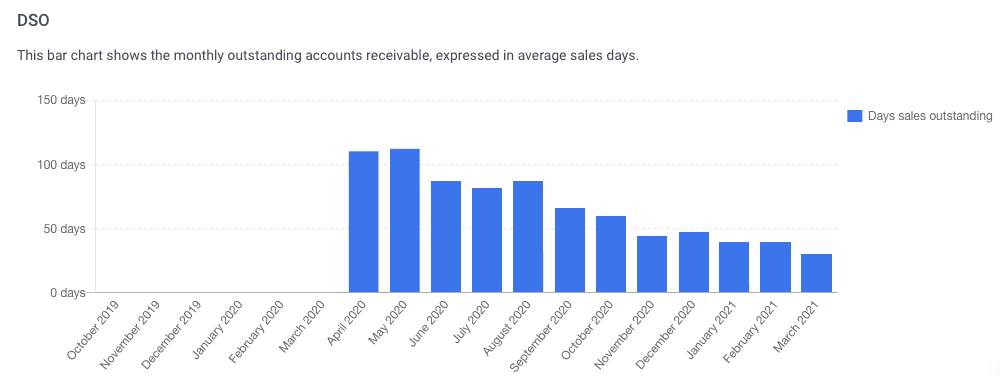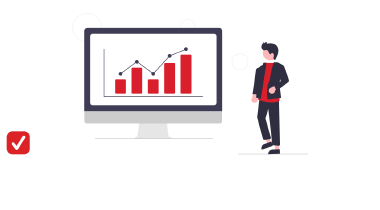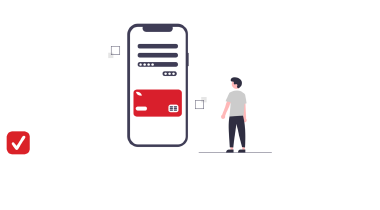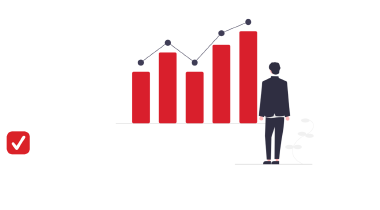Grow your business by mastering your DSO

It is very important to have a positive cash flow to run your business. Covering daily expenses, paying staff and paying off loans. When money flows in more slowly than it goes out, it can be very difficult to grow your business. Or worse, it can get you into financial trouble resulting in a lot of stress. A good solution to this is to control the DSO (Days Sales Outstanding). In this article we will discuss what DSO is, how to calculate it, why it is an important KPI and how to improve it.
What is DSO?
The DSO is the most widely used measurement in the world of credit management. The meaning of DSO is Days Sales Outstanding or Daily Sales Outstanding and is a financial ratio that tells you how well you manage your accounts receivable. DSO is also referred to as the turnover rate of accounts receivable or days sales outstanding.
What does DSO stand for?
The DSO calculation shows how long it takes a company to receive payment for an invoice after a service or product has been delivered to the customer. This is often calculated on a monthly basis to analyse valuable data over a period of time. An effective way is to follow it on a trend line, month by month. This way, changes in your company’s ability to collect outstanding invoices from your customers become clear. You can then anticipate effectively.
How do you calculate your accounts receivable days?
There are several ways to calculate your days in receivables. You can calculate your DSO over a specific period. Many companies do this on a monthly or yearly basis. But different calculations give different results. If you calculate your DSO per month, for example, the DSO figure may be distorted. In a month in which you sell a lot, the DSO will also be higher. And a month in which you sell less will distort your DSO figure. An exceptionally high invoice with a longer payment term can also lead to a distorted DSO. Here are a few formulas to help you calculate your accounts receivable days.
The DSO formulae
There are a number of formulas to calculate the days receivable ratio ratio.
- The DSO formula over a month:
The outstanding invoice amount or debtors at the end of the month /monthly turnover x 30 days
- The DSO formula over a year:
The outstanding invoice amount or accounts receivable at the end of the year / annual sales x 365 days
Days Sales Outstanding example calculation
Here is an example. At the end of June the total amount of your outstanding invoices is €80,000. At the end of July it will be €60,000.
To calculate the total value of your sales you can take the sales turnover in a certain period. If there are many fluctuations in this your DSO will also fluctuate. So, suppose your sales are €88,000 in June and only €40,000 in July, your DSO will be
In June: €80,000.00/ €88,000.00 * 30 days = 27.3 days
In July: €60,000/€40,000 * 31 days = 46.5 days
For a company with these fluctuations in turnover, it is wiser to use the average monthly turnover over 12 months. The days receivable ratio formula reads:
Outstanding invoice amount or accounts receivable balance / (annual turnover/12) * period in days.
What is a good DSO?
In general a DSO below 45 days is considered low and a DSO above 45 days is considered high, but this depends very much on the type of company and the company structure. Different industries have different average DSOs. So a low DSO in one industry can be a high DSO in another. Is the average payment term of your creditors lower than your DSO? If so, you could face cash flow problems. So it’s important to calculate and track your DSO.
What is the importance of a good DSO?
A low DSO is good for your business and a high DSO is undesirable. A high DSO means that a company is selling its products or services on credit and this can lead to cash flow problems. However, many unpaid invoices face increasing risks; the longer the waiting time for a payment, the greater the risk of non-payment. In addition, a low DSO has important advantages for your business. Companies with a low DSO have the highest cash flow and no credit risk. You are therefore more attractive to lenders, business partners and potential investors because your risk is lower.
How can you best keep track of your DSO?
As discussed earlier, calculating and maintaining your DSO is important for the continuity of your business. There are a number of ways in which you can keep track of this.
How to calculate days outstanding for overdue invoices in Excel?
First of all, you can calculate the number of past due days in Excel. This can be useful when you want to know who is overdue with his or her invoices. You can then take immediate action to get your invoice paid as quickly as possible. To calculate how many days have passed between the invoice date and today’s date you can use the TODAY function in Excel. The first step is to put all the invoice dates in column A. In column B you can then use the formula: TODAY()-A1. You can then continue this formula for the other dates. These numbers give a clear picture of which debtor has exceeded the legal payment term of 30 days. So you know exactly where you need to take action. However, this is a time-consuming and inefficient activity.
Keep track of DSO in debtor management software
You can save a lot of time and energy by keeping track of and improving the DSO in your debtor management software. By automatically following up on invoices, offering different payment methods and having a consistent dialogue with your debtors you can significantly reduce your DSO with debtor management software. In the Payt platform you can see at a glance how your DSO is progressing (figure 1).

Figure 1. The reporting of payment behaviour and DSO in Payt
How can you improve your DSO?
So a low DSO is good for your business. But how do you improve your DSO? Here are some tips on how to lower your DSO:
- It is important to invoice your customers immediately after delivery of your product or service. Follow this up quickly in order to be paid sooner. The willingness to pay is greatest immediately after delivery of your product or service.
- Be very precise and specific on your invoice. This avoids questions about the content of the invoice and reduces the chance of your customers throwing it on a pile to be picked up later. It also reduces the chances of you having to send new invoices and call customers back for payment.
- Make it as easy as possible for your customers to pay your invoices. For recurring invoices, it is convenient to use direct debit. It is also very effective to add payment methods such as a Credit Card button in your invoices. You will see that you will be paid much faster. Not only consumers use these payment methods. Companies are also using them more and more. The record of the fastest payment at Hanzehogeschool Groningen stands at 17 seconds after sending the invoice with a payment link in it.
- Make sure that you stay in contact with your customer in an efficient and effective manner. If it is still unclear for the customer make sure that they can contact you easily. Is there a mistake on the invoice or can the customer not pay the amount in one go? Then you want to be able to react quickly to solve this, for example, by automatically making a payment arrangement. The easier this is for your customer, the sooner you can be paid.
- Does the customer not pay the invoice after the payment deadline? Then follow this up immediately by automatically sending reminders at set times. This keeps the payment on top of mind for your customer. Non-payment of invoices is often not a matter of unwillingness, but it is important to be on top of it.
- Use a credit check. With this you examine how reliable your (future) customers are. By keeping an eye on the creditworthiness of your debtors or checking it beforehand you ensure that your DSO remains at the right level.
Criticism of the DSO calculation
Although the DSO calculation is used by many companies, it has also been criticised as a measure of business performance. The reason is that the DSO ’lumps’ everything together. This means averaging large and small amounts, good and bad payers and long and short payment terms. No link is made with the financial health of the portfolio and, as a result, the DSO can change rapidly. So in some cases this will give a too positive result and in other cases a too negative one. You cannot be sure that if a customer pays on time today, he or she will do so next time. So the DSO says little about the future of payment behaviour.
Things to consider
As we mentioned earlier, companies need a positive cash flow to run their business. Many cash flow problems can be prevented by a good strategy. For the survival of your company it is therefore very important to set up your credit management well. A DSO improvement offers a good solution in this respect. Get a grip on your credit management and ensure faster and easier payments.
Related articles

Invoice finance software, a new way of financing your growth

Order to Cash software (O2C)

